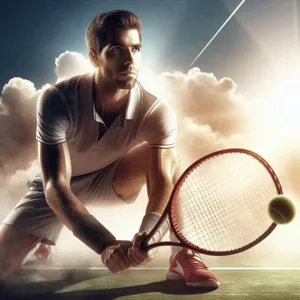Tennis, a sport that combines agility, precision, and mental fortitude, offers players not just a physical challenge but also a pathway to personal growth and mastery.
Whether you’re a beginner eager to grasp the basics or an experienced player looking to refine your techniques, elevating your tennis skills requires a blend of strategic thinking and dedicated practice. In this blog post, we’ll explore essential tips and insights that can transform your game, from sharpening your serve to mastering the art of placement and footwork. Discover how to analyze your opponent, harness the power of visualization, and implement training drills that will enhance your performance on the court. Join us as we delve into the world of tennis strategy, equipping you with the tools you need to play smarter, not just harder, and truly master the game.
1. Understanding the Fundamentals of Tennis

In the world of tennis, mastering the fundamentals is akin to building a solid foundation for a house; without it, everything else risks crumbling. Whether you’re a novice stepping onto the court for the first time or a seasoned player looking to refine your game, understanding the core principles of tennis is crucial.
Begin with the grip, an often-overlooked yet essential element that influences every shot you make. The way you hold your racket—be it the continental, eastern, or western grip—can determine the spin and accuracy of your strokes. Experiment with different grips during practice to discover which feels most comfortable and effective for your playing style.
Next, focus on your stance and footwork. A stable, balanced position allows for greater control and power in your shots. Practice your split step, which is the fundamental move that prepares you to respond quickly to your opponent’s ball. The quicker and more agile your footwork, the better equipped you’ll be to position yourself optimally for each shot, enabling you to hit with precision and confidence.
Beyond grip and footwork, mastering the basic strokes—forehands, backhands, volleys, and serves—is vital. Start with the forehand, which is often your strongest weapon; ensure your swing is fluid and your follow-through is complete. Transition to your backhand, whether you prefer a one-handed or two-handed grip, and practice regularly to cultivate consistency.
Finally, don’t underestimate the importance of understanding the rules of the game and court etiquette. Knowing when to serve, how to keep score, and understanding the different types of faults will not only enhance your gameplay but also ensure you respect the spirit of the sport.
With a firm grasp of these fundamentals, you’re setting the stage for more advanced techniques and strategies. Remember, tennis is not just about the physical aspects; mental fortitude plays a significant role, too. As you embrace these basic skills, you’ll find yourself more confident and prepared to tackle the complexities of the game, paving the way for your growth as a player.
2. The Importance of a Strong Serve
A strong serve can be a game changer in tennis, setting the tone for the entire match and giving you a strategic advantage over your opponent. Imagine stepping up to the baseline, the court stretching out before you, and with one fluid motion, launching the ball into the air. Your serve isn’t just about power; it’s a combination of technique, precision, and placement that can catch your opponent off guard and dictate the rhythm of play.
To master your serve, it’s essential to focus on several key elements. Start with your grip—whether you opt for the Eastern or Continental grip, ensure it feels comfortable and allows you to impart spin effectively. As you prepare for your serve, your stance is equally important; a balanced, athletic posture will give you the stability needed to unleash your full potential.
Practice is crucial; spend time honing your toss, as it sets the foundation for a successful serve. The ball should rise smoothly, allowing you to make consistent contact at the highest point. Experiment with different types of serves—such as flat, topspin, and slice—to keep your opponent guessing and create opportunities to exploit their weaknesses.
Moreover, don’t underestimate the psychological aspect of serving. A strong serve can intimidate your opponent and boost your confidence, making you feel in control from the very first point. By prioritizing the development of a solid serve, you not only improve your overall game but also establish a powerful weapon that can turn the tide in your favor during critical moments in a match. Embrace the journey of refining your serve, and watch as it elevates your performance on the court.
3. Developing Consistent Groundstrokes

Developing consistent groundstrokes is crucial for any tennis player aspiring to elevate their game. Groundstrokes form the backbone of your play, serving as the primary means of rallying and building points during a match. To master this fundamental skill, it’s essential to focus on a combination of technique, footwork, and mental discipline.
Start by establishing a solid foundation with your grip. Whether you prefer the Eastern, Western, or Semi-Western grip, ensure that it feels comfortable and allows for optimal control. Pay attention to your stance; a balanced, athletic position sets the stage for every shot. As the ball approaches, your footwork plays a pivotal role—practice moving swiftly into position to hit the ball with your body aligned and ready for impact.
Strokes should be executed with a smooth, rhythmic motion. Focus on generating power through your legs and core, allowing your racket to follow through naturally. Consistency comes from repetition, so dedicate time to drills that emphasize hitting the ball cleanly and accurately over the net. Whether you’re practicing with a partner or using a ball machine, aim for a target area on the court to hone your precision.
Moreover, mental fortitude is just as important as physical prowess. As you develop your groundstrokes, cultivate a mindset that embraces patience and persistence. Don’t be discouraged by mistakes; instead, use them as learning opportunities. Visualization techniques can help you imagine successful shots, reinforcing your confidence during play.
Lastly, remember to mix up your groundstrokes during practice. Incorporate topspin, slice, and flat shots to develop versatility in your game. The more comfortable you become with different types of groundstrokes, the more unpredictable you will be to your opponents. By focusing on these key elements, you’ll not only enhance your consistency but also transform your groundstrokes into a formidable weapon on the court.
4. Mastering the Art of Footwork
Footwork is often the unsung hero of a successful tennis game. It’s the foundation upon which all other skills are built, and mastering it can elevate your performance from average to exceptional. Think of footwork as the dance that precedes every stroke; it dictates your positioning, timing, and overall ability to respond to your opponent’s shots.
To begin refining your footwork, focus on developing quick, agile movements that allow you to cover the court efficiently. Drills that emphasize lateral movement and sprinting can significantly enhance your speed and agility. For instance, practice side shuffles across the baseline or engage in cone drills that require rapid changes in direction. Not only do these exercises improve your physical agility, but they also train your mind to react swiftly under pressure.
Moreover, pay attention to your stance and balance. A stable base is crucial for executing powerful shots — your feet should always be shoulder-width apart, ready to pivot or sprint at a moment’s notice. Incorporating balance exercises, such as standing on one leg or using a balance board, can help you maintain control during intense rallies.
It’s also beneficial to visualize your movements before they happen. As you watch professional players, notice how they glide effortlessly across the court, anticipating their opponent’s next move. By practicing this mental aspect alongside physical drills, you’ll develop a more instinctive feel for positioning.
Finally, remember that footwork is not just about speed; it’s about efficiency. Often, less is more. Instead of rushing to every ball, learn to read the game and position yourself strategically. This will not only conserve your energy but will also give you a better chance at executing your shots with precision. By mastering the art of footwork, you’ll not only improve your game but also find a renewed sense of confidence on the court.
5. Strategies for Effective Net Play

Net play is an essential component of a well-rounded tennis game, often distinguishing the good players from the great ones. Mastering the art of volleying and positioning can drastically elevate your performance on the court. Here are some strategic tips to help you dominate at the net:
First and foremost, positioning is key. As you approach the net, ensure you’re in a strong athletic stance with your feet shoulder-width apart, knees slightly bent, and your weight evenly distributed. This ready position allows for quick lateral movement, enabling you to respond effectively to your opponent’s shots. Anticipating where the ball will land is crucial; keep your eyes on the ball and gauge your opponent’s body language to predict their next move.
Once you’re at the net, focus on your racket preparation. A short backswing is preferable for volleys, allowing for quicker reaction times. Use a continental grip, which provides the versatility needed for both forehand and backhand volleys. Remember to keep your racket out in front of you, which not only improves your reach but also increases your chances of making solid contact with the ball.
Additionally, mastering the art of the “punch volley” can be a game-changer. Unlike a traditional swing, a punch volley involves minimal racket movement. Instead, you simply redirect the ball with a firm, stable racket face, allowing for more control and precision. This technique is especially effective when dealing with fast-paced shots from your opponent.
Another vital strategy is to communicate with your partner during doubles play. Whether you employ verbal cues or simple gestures, ensuring you’re on the same page minimizes confusion and maximizes your ability to cover the court effectively. Always be aware of your partner’s positioning and be ready to adjust your play accordingly.
Finally, don’t underestimate the power of practice. Incorporate drills focused on net play into your training sessions. Work with a partner or a coach to simulate different scenarios, enhancing your reflexes and shot selection. The more comfortable you become at the net, the more confident you’ll feel executing these strategies in match situations.
By honing your net play skills with these strategies, you’ll not only improve your overall game but also become a more formidable opponent on the court. Remember, the net is where matches can be won or lost, and mastering this area of your game can lead to greater success and satisfaction in your tennis journey.
6. Analyzing Your Opponent’s Weaknesses
Analyzing your opponent’s weaknesses is an essential strategy in elevating your tennis game. Understanding the strengths and vulnerabilities of your competitor can provide you with a significant advantage on the court. This process begins long before the match; it involves observation, preparation, and tactical thinking.
As you watch your opponent play—whether in practice sessions, previous matches, or tournaments—pay close attention to their playing style. Do they struggle with high-bouncing balls? Are their backhand shots weaker than their forehands? Do they lose focus during long rallies? Taking mental notes of such details can help you formulate a game plan tailored specifically to exploit these weaknesses.
Once you’re aware of their tendencies, you can strategize your shots accordingly. For instance, if you notice that your opponent has difficulty returning serves that are angled wide, make it a point to incorporate more slices and spins that can push them off balance. Conversely, if they seem to falter under pressure, apply strategic aggression by playing more aggressively during crucial points of the match.
In addition to physical weaknesses, consider psychological factors. Observe how they react to mistakes or pressure situations. Some players may become flustered after a missed shot, while others thrive under pressure. Use this knowledge to apply psychological tactics, such as varying your pace or rhythm to disrupt their focus.
Remember, analyzing your opponent is not just about identifying weaknesses—it’s about adapting your game to exploit them effectively. By remaining observant and flexible in your approach, you’ll not only enhance your performance but also gain the upper hand in your matches. Master this skill, and you’ll find that each match becomes a strategic chess game where you are one step ahead.
7. Mental Toughness: The Key to Winning Matches

In the world of tennis, where matches can swing dramatically with the momentum of a single point, mental toughness emerges as a pivotal factor distinguishing the champions from the rest. While technical skills and physical fitness lay the groundwork for success, it is the mental fortitude that often determines who walks away victorious. Developing a resilient mindset allows players to navigate the highs and lows of the game with grace and determination.
Mental toughness begins with self-belief. Visualizing success, embracing a positive mindset, and trusting in one’s training are crucial components. As you step onto the court, it’s essential to foster an unwavering confidence that you can handle whatever the match throws your way. This inner strength can help you maintain focus and composure, even in the face of adversity—whether it’s a string of lost points, an opponent’s powerful serve, or the pressure of a match point.
Equally important is the ability to manage emotions. Tennis is as much a psychological battle as it is a physical one. Cultivating emotional intelligence allows players to stay calm under pressure, preventing frustration or anxiety from clouding their performance. Techniques such as deep breathing, mindfulness, and positive self-talk can be invaluable tools in maintaining a clear and focused mindset during critical moments.
Moreover, learning to embrace challenges rather than shy away from them fosters resilience. Every match is an opportunity for growth, and viewing setbacks as valuable lessons can transform how you approach your game. Understanding that even the greatest players face defeats can help normalize the experience of loss, encouraging a mindset of perseverance and continuous improvement.
Ultimately, the path to mastering tennis involves honing both your physical skills and your mental game. By prioritizing mental toughness, you not only elevate your performance on the court but also equip yourself to face the challenges of competition head-on. Embrace the power of a strong mindset, and watch as your confidence and results soar, turning every match into an opportunity for triumph.
8. Crafting a Game Plan for Different Court Surfaces
Crafting a game plan for different court surfaces is essential for any serious tennis player looking to elevate their skills and adapt their strategy effectively. Each surface—be it clay, grass, or hard court—offers distinct characteristics that can influence the way the ball bounces, the speed of play, and your overall performance. Understanding these nuances can give you a competitive edge.
On clay courts, for instance, the slower surface allows for longer rallies and emphasizes stamina and strategic shot placement. Here, you’ll want to incorporate a game plan that focuses on constructing points thoughtfully. Utilize heavy topspin shots to push your opponent back, and be prepared to engage in extended exchanges. Movement is crucial; practice your footwork to slide into shots and position yourself optimally for the next play.
In contrast, grass courts provide a faster-playing surface that rewards quick reflexes and attacking play. The ball skids low, making it essential to capitalize on your serve and volley. Crafting a game plan for grass involves being aggressive from the outset—aim for quick points and employ a strong serve to keep your opponents on the defensive. Perfect your volleying skills and practice your positioning at the net, as these will be key to winning points swiftly.
Hard courts offer a blend of speed and bounce, making them the most versatile surface. A successful game plan here often revolves around a balanced approach, mixing powerful groundstrokes with strategic net play. Focus on your serve and return of serve, as these aspects of your game can set the tone for the entire match. By varying your shots and keeping your opponent guessing, you can exploit both their weaknesses and the court’s unique characteristics.
Regardless of the surface, it’s vital to analyze your opponent’s strengths and weaknesses as part of your game plan. Tailor your strategy to exploit their vulnerabilities while playing to your own strengths. Take time during practice sessions to simulate match conditions on different surfaces, honing your adaptability and refining your tactics. By mastering the art of crafting a surface-specific game plan, you’ll not only elevate your skills but also increase your chances of success on the court.
9. The Role of Fitness and Conditioning in Tennis
In the exhilarating world of tennis, skill and technique are undoubtedly paramount, but they are only part of the equation for success on the court. The role of fitness and conditioning cannot be overstated, as it serves as the backbone of a player’s performance. Tennis demands a unique blend of speed, agility, endurance, and strength, all of which can be optimized through a well-rounded fitness regimen.
To truly elevate your game, it’s essential to embrace a comprehensive conditioning program tailored specifically for tennis. This encompasses cardiovascular exercises to enhance your stamina, allowing you to maintain peak performance throughout long matches. Incorporating interval training can simulate the bursts of energy required during rallies, improving your ability to recover quickly between points.
Strength training is equally crucial, as it builds the muscle necessary for powerful serves and groundstrokes. Focus on core stability and leg strength, as a strong foundation translates to better balance and explosive movement on the court. Exercises like squats, lunges, and planks should become staples in your workout routine.
Moreover, agility drills such as ladder exercises and cone sprints will sharpen your footwork, enabling you to navigate the court with ease and precision. A quick first step can be the difference between reaching a challenging shot or letting it sail past you.
Finally, flexibility cannot be overlooked. Regular stretching and mobility exercises will enhance your range of motion, reducing the risk of injury and allowing for fluid, natural movements during gameplay. Incorporating yoga or Pilates into your routine can also improve mental focus and relaxation, both vital for high-pressure situations.
In essence, fitness and conditioning are not just supplementary to your tennis training; they are integral components that can significantly influence your performance. By committing to a holistic approach to fitness, you will not only enhance your skills on the court but also build the resilience needed to thrive in this competitive sport.
10. Utilizing Drills to Improve Specific Skills
When it comes to elevating your tennis game, targeted practice is key—and that’s where utilizing drills to improve specific skills comes into play. Drills are not just exercises; they are focused training sessions designed to hone particular aspects of your game, whether it’s your serve, volley, backhand, or footwork. By incorporating a variety of drills into your practice routine, you can systematically address weaknesses and build on your strengths.
For example, if you struggle with your serve, consider dedicating a session to serving drills that emphasize different angles and spins. Start with basic toss and motion repetitions to establish consistency, then progress to targeting specific areas of the service box. Use cones or markers to create visual targets, transforming each serve into a challenge and enhancing your accuracy over time.
Similarly, if your volley needs work, partner up and engage in volley drills that focus on reflexes and positioning. Set a rhythm by alternating shots—first at the net and then at the baseline—to improve your reaction time and court coverage. This type of focused practice not only builds muscle memory but also instills a sense of confidence in your ability to execute under pressure.
Incorporating footwork drills is another vital element. Tennis is a sport that demands quick, agile movements, so dedicating time to agility ladder drills or cone sprints can significantly improve your court movement. This will not only help you reach the ball more effectively but also allow you to position yourself better for your next shot.
To maximize the benefits of these drills, keep a journal to track your progress. Note what works, what needs improvement, and how you feel after each session. This self-reflection will keep you motivated and provide insights into your development as a player.
In summary, utilizing drills to improve specific skills is an essential strategy for mastering tennis. By targeting your practice, you’ll gain the precision and agility needed to elevate your game, transforming you from a recreational player into a formidable competitor. Embrace the process, stay dedicated, and watch your skills flourish on the court.
11. The Value of Watching and Learning from Professionals
Watching and learning from professional tennis players can be one of the most enlightening experiences for aspiring athletes. The sheer athleticism, precision, and strategic thinking displayed by these elite competitors provide invaluable lessons that can significantly elevate your own game. When you tune in to a match, you’re not just witnessing an event; you’re observing a masterclass in technique, mental fortitude, and tactical execution.
As you watch the pros, pay close attention to their footwork—the way they glide across the court with grace and efficiency. Notice how they position themselves to hit the ball, often anticipating their opponent’s next move. This is not merely instinct; it’s a culmination of years of training and understanding of the game that you can learn from.
Additionally, analyze their shot selection during different phases of the match. Observe how they exploit their opponent’s weaknesses while capitalizing on their own strengths. Whether it’s a powerful serve or a delicate drop shot, each decision is calculated and purposeful. By studying these choices, you can refine your own strategic thinking on the court, making you a more versatile player.
Don’t forget to take advantage of the wealth of instructional content available online. Many professional players share tips and drills through social media platforms and YouTube channels, breaking down complex techniques into digestible segments. Incorporating these insights into your practice routine can help you develop a deeper understanding of the game.
Finally, remember that watching professionals isn’t just about emulating their skills; it’s also about absorbing their mentality. Notice how they handle pressure, navigate setbacks, and celebrate victories. Their ability to stay focused and composed under duress is a testament to their training and mindset—qualities you can cultivate in your own game. By absorbing these lessons, you’ll not only improve your technical skills but also enhance your overall approach to competition, ultimately propelling you to new heights in your tennis journey.
12. Overcoming Common Psychological Barriers
In the world of tennis, mastering your physical skills is only half the battle; the other half resides in the mind. Psychological barriers can be insidious, creeping into your game and affecting your performance when you least expect it. Whether it’s the fear of failure, anxiety during matches, or negative self-talk, these mental hurdles can undermine your hard-earned skills.
To overcome these challenges, it’s crucial to first acknowledge their existence. Take a moment to reflect on your feelings before a match or during critical points in a game. Are you worried about letting down your coach, teammates, or even yourself? Once you recognize these thoughts, you can start to reframe them. Instead of thinking, “I can’t afford to lose,” shift your focus to “I’m excited to play and improve.” This positive mindset can significantly impact your performance.
Visualization is another powerful tool in your mental arsenal. Spend time imagining yourself on the court, executing your serves and volleys flawlessly. Picture the crowd cheering as you hit that winning shot. By regularly visualizing success, you can program your mind to expect positive outcomes, making it easier to perform under pressure.
Additionally, consider incorporating mindfulness practices into your routine. Techniques such as deep breathing, meditation, or even yoga can help you stay grounded and focused. When you feel your anxiety creeping in, take a few deep breaths to center yourself, bringing your focus back to the present moment rather than worrying about the future.
Finally, cultivate a growth mindset. Embrace the idea that mistakes are opportunities for learning rather than indicators of failure. By viewing each match as a chance to improve, you can reduce the pressure you place on yourself, allowing for a more enjoyable and fulfilling experience on the court.
By addressing and overcoming these common psychological barriers, you can elevate your game, enhance your focus, and ultimately, boost your performance. Remember, tennis is as much a mental game as it is a physical one, and mastering the psychological aspects can lead to significant improvements in your overall skills.
13. Keeping a Competitive Edge: The Importance of Practice
When it comes to mastering tennis, the importance of practice cannot be overstated. It’s the backbone of any athlete’s success, the secret ingredient that transforms potential into performance. Each time you step onto the court, you’re not just hitting the ball; you’re honing your skills, deepening your understanding of the game, and building the muscle memory necessary for executing complex shots under pressure.
But effective practice goes beyond mere repetition. To truly keep a competitive edge, you need to incorporate structured drills that target specific areas of your game. For instance, if your serve lacks power or accuracy, dedicate practice sessions to serving techniques, focusing on your grip, stance, and follow-through. Similarly, if your groundstrokes feel inconsistent, spend time rallying with a partner or against a wall, concentrating on footwork and timing.
Variety is also key. Mixing up your practice routine not only keeps things fresh and engaging but also challenges different aspects of your skill set. Consider incorporating match simulations where you can apply your skills in a competitive context, or participate in drills that enhance your agility and speed, ensuring you can respond to your opponent’s shots effectively.
Moreover, practice isn’t just about the physical aspect; it’s a mental game as well. Visualization techniques, where you picture yourself executing perfect shots or winning crucial points, can enhance your confidence and focus. Regularly reflecting on your performance and setting achievable goals will also help you track your progress and stay motivated.
Remember, the path to improvement is not just paved with talent but with dedication and perseverance. The more intentional and focused your practice sessions are, the more you will elevate your tennis skills and keep that competitive edge sharp for every match you face.
14. Setting Realistic Goals for Improvement
Setting realistic goals for improvement is a cornerstone of mastering your tennis game. While it’s tempting to dream big, aspiring to transform into a top-tier player overnight can often lead to frustration and burnout. Instead, consider breaking down your ambitions into smaller, manageable objectives that can be realistically achieved over time.
Start by assessing your current skill level. Are you struggling with your serve? Focus on improving that specific shot before moving on to enhance your volleys or baseline strokes. For instance, set a goal to practice serving for 30 minutes at least twice a week, gradually increasing both your accuracy and power. Celebrate these small victories along the way, as they will serve to motivate you and build your confidence.
Additionally, consider incorporating measurable aspects into your goals. For example, aim to improve your first serve percentage from 50% to 60% over the next month. By tracking your progress, you’ll not only gain a clearer understanding of your improvement but also maintain a sense of accountability.
Remember to be flexible in your goal-setting. As you progress, you may find certain areas of your game require more attention than you initially anticipated. Embrace this adaptability, adjusting your targets as you develop new skills and insights. Surround yourself with supportive teammates or coaches who can provide constructive feedback, helping you refine your goals and keep your focus sharp.
Ultimately, setting realistic goals creates a roadmap for your tennis journey. It fosters a growth mindset, allowing you to appreciate the incremental improvements that lead to long-term success. With patience and persistence, you’ll find that each small goal achieved brings you one step closer to mastering the game you love.
15. Staying Motivated: Tips for Continuous Growth in Tennis
Staying motivated in tennis can often feel like a match against a formidable opponent—a blend of mental fortitude, passion, and perseverance. To achieve continuous growth in your skills, it’s essential to cultivate an unwavering motivation that fuels your desire to improve. Here are some practical tips to keep your enthusiasm alive and thriving on the court.
First and foremost, set specific, measurable goals. Whether it’s improving your serve speed, mastering a new shot, or increasing your match win percentage, having clear objectives gives you a target to aim for. Break these goals down into smaller milestones, celebrating each achievement along the way—this not only keeps your motivation high but also provides a tangible sense of progress.
Another effective strategy is to vary your practice routines. Repetition is crucial for honing skills, but monotony can lead to burnout. Incorporate different drills, play with various partners, and participate in friendly matches to keep your training fresh and engaging. This variety not only enhances your skill set but also reignites your passion for the game.
Surround yourself with a supportive community. Engage with fellow players, join local clubs, or participate in online forums where you can share experiences, tips, and encouragement. The camaraderie of a motivated group can be incredibly inspiring, reminding you that you’re not alone in your journey. Celebrate each other’s successes, whether big or small, to foster a culture of mutual support.
Lastly, remember to celebrate your love for the game. Watch professional matches, study the techniques of your favorite players, or even engage in tennis-related activities off the court, like reading books or watching documentaries. Keeping the sport at the forefront of your mind can reignite your passion and remind you of the joy that tennis brings.
By incorporating these strategies, you can maintain your motivation and continue to grow as a player. Tennis is not just about wins and losses; it’s about the journey, the friendships, and the relentless pursuit of improvement. Embrace every moment, and watch as your skills—and love for the game—thrive.
As we conclude our exploration of the strategic tips to elevate your tennis skills, it’s clear that mastering the game goes beyond mere practice—it involves a holistic approach to your training, mindset, and on-court tactics. By integrating these insights, from refining your footwork to honing your mental resilience, you can take your game to new heights. Remember, every champion was once a beginner, and the journey of improvement is as rewarding as the victories themselves. So, lace up your shoes, hit the courts, and embrace the challenges ahead with confidence. We can’t wait to see how these strategies transform your game—share your progress with us, and let’s celebrate your growth together!






